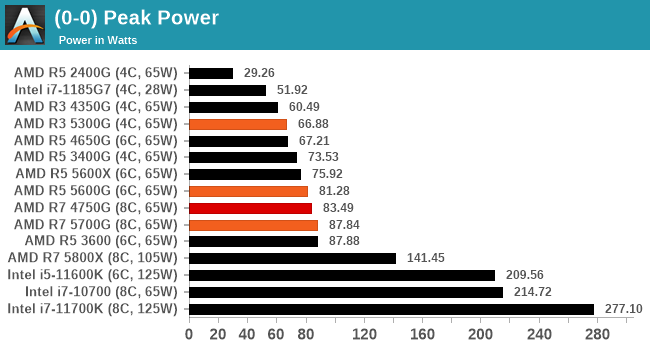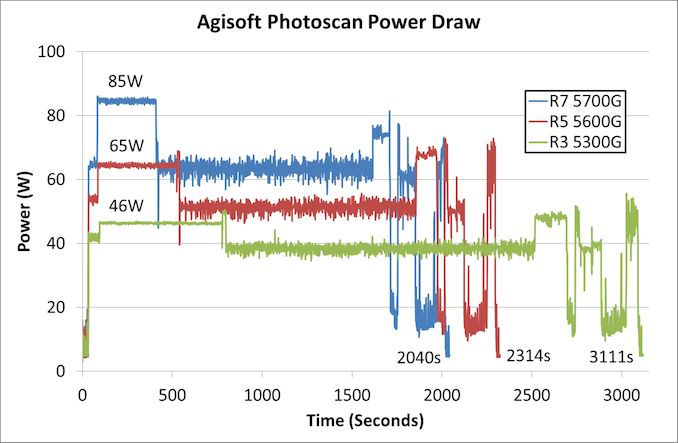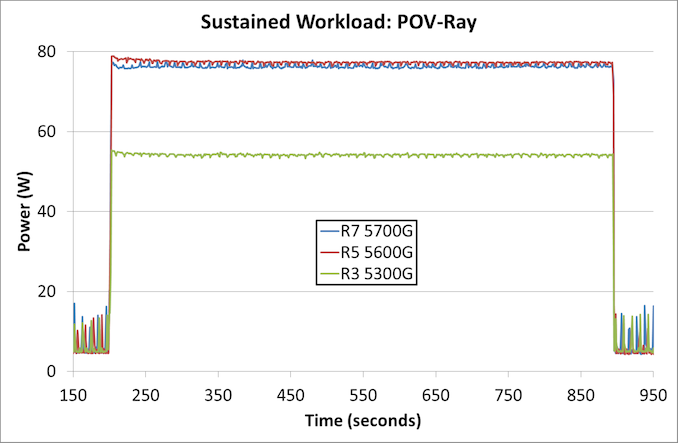The AMD Ryzen 7 5700G, Ryzen 5 5600G, and Ryzen 3 5300G Review
by Dr. Ian Cutress on August 4, 2021 1:45 PM ESTPower Consumption
The nature of reporting processor power consumption has become, in part, a dystopian nightmare. Historically the peak power consumption of a processor, as purchased, is given by its Thermal Design Power (TDP, or PL1). For many markets, such as embedded processors, that value of TDP still signifies the peak power consumption. For the processors we test at AnandTech, either desktop, notebook, or enterprise, this is not always the case.
Modern high-performance processors implement a feature called Turbo. This allows, usually for a limited time, a processor to go beyond its rated frequency. Exactly how far the processor goes depends on a few factors, such as the Turbo Power Limit (PL2), whether the peak frequency is hardcoded, the thermals, and the power delivery. Turbo can sometimes be very aggressive, allowing power values 2.5x above the rated TDP.
AMD and Intel have different definitions for TDP, but are broadly speaking applied the same. The difference comes to turbo modes, turbo limits, turbo budgets, and how the processors manage that power balance. These topics are 10000-12000 word articles in their own right, and we’ve got a few articles worth reading on the topic.
- Why Intel Processors Draw More Power Than Expected: TDP and Turbo Explained
- Talking TDP, Turbo and Overclocking: An Interview with Intel Fellow Guy Therien
- Reaching for Turbo: Aligning Perception with AMD’s Frequency Metrics
- Intel’s TDP Shenanigans Hurts Everyone
In simple terms, processor manufacturers only ever guarantee two values that are tied together - when all cores are running at base frequency, the processor should be running at or below the TDP rating. All turbo modes and power modes above that are not covered by warranty. Intel kind of screwed this up with the Tiger Lake launch in September 2020, by refusing to define a TDP rating for its new processors, instead of going for a range. Obfuscation like this is a frustrating endeavor for press and end-users alike.
However, for our tests in this review, we measure the power consumption of the processor in a variety of different scenarios. These include workflows, real-world image-model construction, and others as appropriate. These tests are done as comparative models. We also note the peak power recorded in any of our tests.
First up is our image-model construction workload, using our Agisoft Photoscan benchmark. This test has a number of different areas that involve single thread, multi-thread, or memory limited algorithms.
For the Ryzen 7 5700G, the most power-hungry part of the test is right at the beginning, where we’re seeing peaks of 85 W. For the 5600G, that first section goes to 65 W, but the peaks actually occur here near the end of the test. The 5300G also has peaks later in the test, but that first section is the lowest, running only at 46 W.
The second test is a sustained rendering workload.
In this instance, the Ryzen 3 5300G is nearer 55 W with a sustained workload over 10 minutes, while the Ryzen 5 and Ryzen 7 sit just below 80 W.
For peak power, we report the highest value observed from any of our benchmark tests.

While all three processors have a TDP rating of 65 W, by default on AMD systems the Package Power Tracking, which is the limiting factor here, is 88 W. The Ryzen 7 is practically at that value, while the Ryzen 5 just goes a smidge over 80 W. The Ryzen 3 on the other hand only matches its TDP in the worst-case scenario.












135 Comments
View All Comments
GeoffreyA - Thursday, August 5, 2021 - link
Yes, great follow-up article, that.nemi2 - Thursday, August 5, 2021 - link
Does anyone know if these 5x00G support 4k HDR, VVR, at 120Hz? I see some B550 MB advertise HDMI 2.1id4andrei - Thursday, August 5, 2021 - link
An overclocking section would be nice, with a focus on the iGPU only.Gasaraki88 - Thursday, August 5, 2021 - link
I'm worried about the performance of the Steam Deck.nandnandnand - Saturday, August 7, 2021 - link
https://videocardz.com/newz/steam-decks-rdna2-gpu-...Fulljack - Monday, August 9, 2021 - link
Steam Deck uses the much faster LPDDR5-5500 RAM and much powerful RDNA2 iGPU.mode_13h - Tuesday, August 10, 2021 - link
Yeah, but its iGPU is still 8 CUs. I think it's telling they went with 1280x800 resolution. Probably enough for a screen that size, and framerates are reportedly good.I do kinda wish they'd gone with a bigger iGPU, but maybe silicon prices these days pushed too hard against that. I think their goal should be to counter a plausible next-gen Nintendo Switch, and I'm not confident they got there.
Unlike Sony & MS, Valve can't afford to sell the hardware at a loss. The upside of that is that Valve isn't making it a walled garden. So, you should be able to load and run non-Steam software on it!
GreenReaper - Monday, August 16, 2021 - link
Compared to everything else in that form factor, it should be great. You probably won't be able to run most modern games at High and hit a solid 60FPS, or perhaps even 30FPS. But Medium might work. Meanwhile the competition is on Low with a few extra tweaks, and running games specifically designed for it (and likely costing a lot more). Heck, you might even be able to emulate them.The_Assimilator - Thursday, August 5, 2021 - link
Way too expensive, especially when you consider these chips lose out on PCIe 4.0 and are still using the ancient and terrible Vega.pman6 - Thursday, August 5, 2021 - link
i've used a prebuilt 5700G system, and for some reason, the Intel rocket lake runs smoother in certain applications like stock trading and java based apps.The only downside is that Intel is a power hog